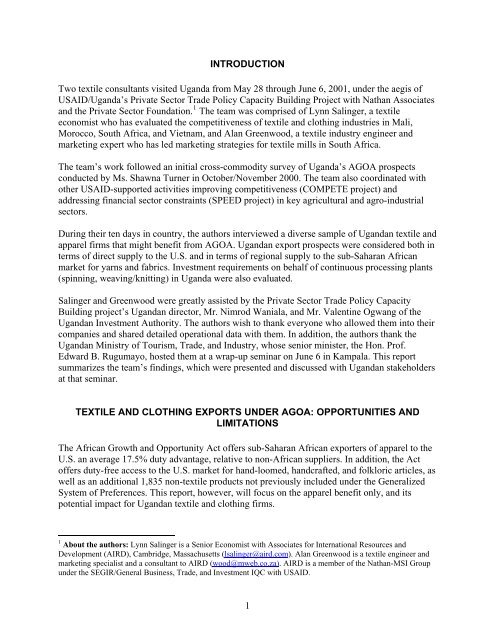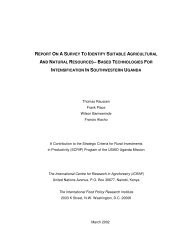Create successful ePaper yourself
Turn your PDF publications into a flip-book with our unique Google optimized e-Paper software.
INTRODUCTION<br />
Two textile consultants visited Uganda from May 28 through June 6, 2001, under the aegis of<br />
USAID/Uganda’s Private Sector Trade Policy Capacity Building Project with <strong>Nathan</strong> Associates<br />
and the Private Sector Foundation. 1 The team was comprised of Lynn Salinger, a textile<br />
economist who has evaluated the competitiveness of textile and clothing industries in Mali,<br />
Morocco, South Africa, and Vietnam, and Alan Greenwood, a textile industry engineer and<br />
marketing expert who has led marketing strategies for textile mills in South Africa.<br />
The team’s work followed an initial cross-commodity survey of Uganda’s AGOA prospects<br />
conducted by Ms. Shawna Turner in October/November 2000. The team also coordinated with<br />
other USAID-supported activities improving competitiveness (COMPETE project) and<br />
addressing financial sector constraints (SPEED project) in key agricultural and agro-industrial<br />
sectors.<br />
During their ten days in country, the authors interviewed a diverse sample of Ugandan textile and<br />
apparel firms that might benefit from AGOA. Ugandan export prospects were considered both in<br />
terms of direct supply to the U.S. and in terms of regional supply to the sub-Saharan African<br />
market for yarns and fabrics. Investment requirements on behalf of continuous processing plants<br />
(spinning, weaving/knitting) in Uganda were also evaluated.<br />
Salinger and Greenwood were greatly assisted by the Private Sector Trade Policy Capacity<br />
Building project’s Ugandan director, Mr. Nimrod Waniala, and Mr. Valentine Ogwang of the<br />
Ugandan Investment Authority. The authors wish to thank everyone who allowed them into their<br />
companies and shared detailed operational data with them. In addition, the authors thank the<br />
Ugandan Ministry of Tourism, Trade, and Industry, whose senior minister, the Hon. Prof.<br />
Edward B. Rugumayo, hosted them at a wrap-up seminar on June 6 in Kampala. This report<br />
summarizes the team’s findings, which were presented and discussed with Ugandan stakeholders<br />
at that seminar.<br />
TEXTILE AND CLOTHING EXPORTS UNDER AGOA: OPPORTUNITIES AND<br />
LIMITATIONS<br />
The African Growth and Opportunity Act offers sub-Saharan African exporters of apparel to the<br />
U.S. an average 17.5% duty advantage, relative to non-African suppliers. In addition, the Act<br />
offers duty-free access to the U.S. market for hand-loomed, handcrafted, and folkloric articles, as<br />
well as an additional 1,835 non-textile products not previously included under the Generalized<br />
System of Preferences. This report, however, will focus on the apparel benefit only, and its<br />
potential impact for Ugandan textile and clothing firms.<br />
1 About the authors: Lynn Salinger is a Senior Economist with Associates for International Resources and<br />
Development (AIRD), Cambridge, Massachusetts (lsalinger@aird.com). Alan Greenwood is a textile engineer and<br />
marketing specialist and a consultant to AIRD (wood@mweb.co.za). AIRD is a member of the <strong>Nathan</strong>-<strong>MSI</strong> <strong>Group</strong><br />
under the SEGIR/General Business, Trade, and Investment IQC with USAID.<br />
1
















